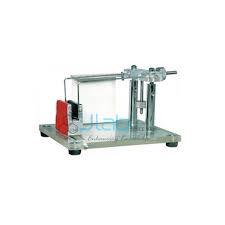Spherometer

Product Details:
- Color Silver And Golden And Black
- Product Type Spherometer
- Material Metal And Brass
- Usage Laboratory
103 INR/Piece
X
Spherometer Price And Quantity
- 1 Piece
- 103 INR/Piece
Spherometer Product Specifications
- Silver And Golden And Black
- Laboratory
- Spherometer
- Metal And Brass
Spherometer Trade Information
- Cash in Advance (CID), Cash Advance (CA)
- 1000 Piece Per Week
- 1 Week
- Yes
- Sample costs shipping and taxes has to be paid by the buyer
- South America, Eastern Europe, Western Europe, Middle East, Central America, Asia, North America, Australia, Africa
- All India
Product Description
Calibrating the Spherometer
To calibrate (zero) the spherometer, you place the 3-legs (or rim of the cone in the cone type) onto the flatness reference. Insert the depth probe of the calipers through the center hole of the fixture, as if to measure the depth from the top of the fixture to the reference surface, and push the "zero" button to set the digital calipers to read zero at that depth. You can also zero to a lens of known precision curvature, and add the corresponding depth to subsequent measurements.
Measuring Spherical Curvature with the Spherometer
To measure a convex curvature, you probe the depth again with the digital calipers, this time to the subject lens surface from the top of the fixture, and record this distance. The radius of curvature is then R = r^2/2h + h/2, where r is the radius of the bolt circle (tips of the screws in the 3-leg design, or radius of the rim in the round type), and h is the depth measurement.
The bolt-circle diameter on the 3-leg spherometer is adjustable between 3 selections of 15mm, 30mm, or 50mm. To change the diameter, you simply remove the screws from one set of holes and insert them in the other. For best accuracy, you should use the largest diameter that is still smaller than the lens being measured. I chose 50mm as the largest size because that is about the largest diameter of lenses I work with. The design scales proportionately to larger sizes if needed.
Measuring a concave curvature is similar, except you may need to manipulate a small ball bearing of known diameter between the caliper depth probe and concave surface.
The instrument also allows quick comparisons of lenses by setting the curvature depth of one lens to zero on the calipers, and then probing other lenses.
To calibrate (zero) the spherometer, you place the 3-legs (or rim of the cone in the cone type) onto the flatness reference. Insert the depth probe of the calipers through the center hole of the fixture, as if to measure the depth from the top of the fixture to the reference surface, and push the "zero" button to set the digital calipers to read zero at that depth. You can also zero to a lens of known precision curvature, and add the corresponding depth to subsequent measurements.
Measuring Spherical Curvature with the Spherometer
To measure a convex curvature, you probe the depth again with the digital calipers, this time to the subject lens surface from the top of the fixture, and record this distance. The radius of curvature is then R = r^2/2h + h/2, where r is the radius of the bolt circle (tips of the screws in the 3-leg design, or radius of the rim in the round type), and h is the depth measurement.
The bolt-circle diameter on the 3-leg spherometer is adjustable between 3 selections of 15mm, 30mm, or 50mm. To change the diameter, you simply remove the screws from one set of holes and insert them in the other. For best accuracy, you should use the largest diameter that is still smaller than the lens being measured. I chose 50mm as the largest size because that is about the largest diameter of lenses I work with. The design scales proportionately to larger sizes if needed.
Measuring a concave curvature is similar, except you may need to manipulate a small ball bearing of known diameter between the caliper depth probe and concave surface.
The instrument also allows quick comparisons of lenses by setting the curvature depth of one lens to zero on the calipers, and then probing other lenses.
Tell us about your requirement

Price:
Quantity
Select Unit
- 50
- 100
- 200
- 250
- 500
- 1000+
Additional detail
Mobile number
Email







